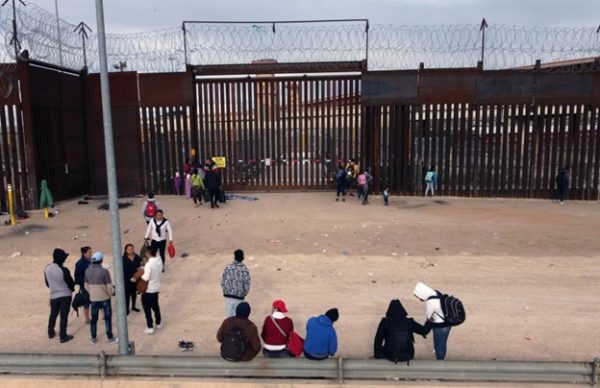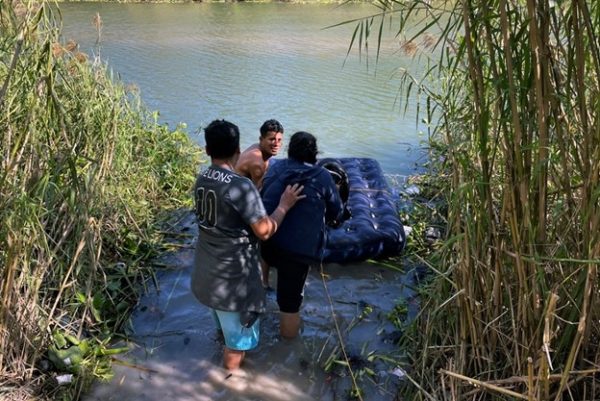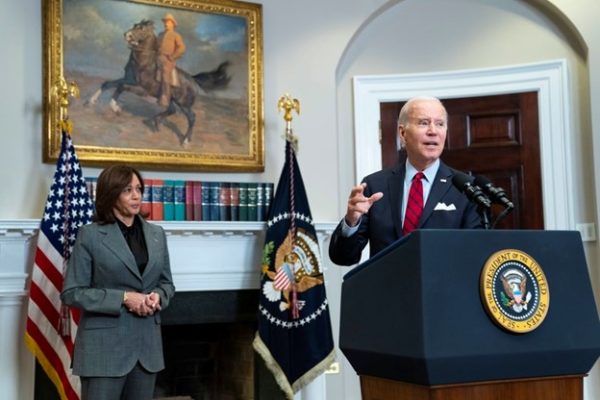Migrants Left in “Migratory Limbo” as Biden Slams the Door

The new plan for US immigration will aggravate the humanitarian crisis in Nicaragua, Cuba and Haiti by reducing the number of migrants fleeing repression and economic crisis who can enter.
HAVANA TIMES – Thousands of Nicaraguans, Cubans and Haitians who were en route to the United States were left in “migration limbo” after US President Joe Biden abruptly implemented a new government plan. As of Thursday, January 5th, migrants can no longer illegally enter US territory. Their options, according to migration specialists, are to remain “stranded” in Mexico or to return to the countries which they fled because of the repression and economic crisis.
On January 5, President Biden announced a new plan, in which all Nicaraguans, Cubans and Haitians who come to the US border will be immediately expelled to Mexico under Title 42. Recently the same measure was applied on Venezuelans. This controversial public health measure, which the current administration inherited from former president Donald Trump, limits access to asylum at the border.
“My message is this: if you’re trying to leave Cuba, Nicaragua, or Haiti, don’t come to the border. Stay where you are and fill out a legal request,” Biden stated at a White House press conference following the announcement.
The US government also informed that they’ll accept 30,000 migrants a month from Nicaragua, Venezuela, Cuba and Haiti combined, but that they will also “immediately” expel citizens of these countries who try to cross the border without a valid visa.
Pablo Cuevas, himself a migrant who now works as a human rights advocate, indicated that the measure will directly impact Nicaraguans who are currently in Mexico and were preparing to cross. Many of them sold their belongings and took on loans with high interest rates to fund their trip, trusting that the policy of allowing entry to nearly all who requested asylum would continue. These people are now left in “limbo.”
“We have reports from Mexican cities like San Pedro and Tapachula (in the south of Mexico) of thousands of Nicaraguans who are waiting there [to continue their journey to the US border]. We know this, because they’re calling us daily, asking for guidance. The families of people stranded in Mexico are also calling us,” Cuevas explained. He works for a Miami-based non-profit, the Defensoria de Nicaragua de Derechos Humanos, or Nicaraguan Human Rights Defense Office.
Cuevas warned that the Nicaraguan migrants in Mexico are vulnerable to the escalating crime in Mexico. Family members of migrants have already denounced the wave of kidnappings of Nicaraguans in the last few months, as well as frequent sexual crimes committed against migrating women.
The US government’s decision came after statistics from fiscal year 2022 highlighted the unprecedented total of 2.76 million undocumented migrants apprehended at the US border this year. Nicaraguans, Cubans and Venezuelans led this record wave of US migration. Between January and October of 2022, some 147,277 Nicaraguans were picked up by US Border Patrols, far surpassing the 87,749 Nicaraguans who turned themselves in to border authorities in 2021.
The US Department of Homeland Security justified the expansion of Title 42 to Nicaraguans, Cubans and Haitians, who were previously considered exempt, by citing the 90% reduction in Venezuelans apprehended at the border after a similarly restrictive policy was implemented for that nationality last October.
Nonetheless, hundreds of Venezuelan migrants continue entering the US illegally, undetected by the migration officials, but exposed to more dangerous crossings.
“Title 42 is a failure. It has only served to encourage migrants to attempt repeated illegal crossings, in areas ever more remote and dangerous,” declared Marisa Limon Garza, executive director of the organization Las Americas, in a press statement.

Requirements and exclusions for the new plan
The immigration measure that entered into effect immediately after being announced stipulates that citizens of Nicaragua, Cuba and Haiti who wish to migrate to the United States must do so through a program termed “conditional liberty.” This status allows those benefitted to live and work in the country for a period of two years.
“Up to 30,000 people a month from these four countries could come to the United States for a period of two years, with permission to work,” DHS sources explained, “as long as they have a sponsor that meets the requirements, and they pass their background checks.
To apply for the Venezuelan program established last October, the Department of Homeland Security also required that interested parties demonstrate they have a sponsor with legal US immigration status and sufficient financial resources to cover the time period in which the migrants will be staying in the country.
It’s still not clear whether the quota of 30,000 migrants to be allowed legal entry will be divided equitably among the four nationalities, or if beneficiaries will be selected on a first-come-first-served basis. However, Astrid Montealegre, supervising attorney for the Nicaragua American Human Rights Alliance, pointed out another problem aspiring migrants will face.
“The great limitation we see in this policy is that it only allows Nicaraguan, Cuban and Haitian migrants to migrate through close family who are residents or citizens of the United States. We know that the majority of the migrants who are currently arriving in an irregular way don’t have a relative they can count on that’s a citizen or a resident,” she stressed.
It’s also still unclear how the procedures for applying from Nicaragua will work, for those who wish to migrate in the upcoming months.
This migration program excludes anyone who’s been deported from the United States in the last five years. It also will not accept people who currently hold permanent residency or nationality in a country other than the four specified.
Astrid Montealegre explained that migrants who are currently in US detention centers will continue to be processed under the former system. However, if they’re unable to adequately support their asylum claims, they’ll be deported and considered ineligible to apply in the new humanitarian program in the future.
“Those people who arrive at the border from [January 5] on, will be subject to expedited expulsion. This doesn’t count as a deportation, because they will not be legally received, but simply turned back in an expedited manner,” she underlined.

Measures won’t resolve the humanitarian crisis
High-level functionaries of the Biden administration explained in a press call with reporters that the aim of these measures is to respond to a “new migratory pattern” being seen at the border. “The political and economic instability all over the world is feeding some of the largest migration levels” seen since World War II.
As part of this panorama, the US has seen record numbers of migrants arriving at its borders, in quantities not known for decades. They all try to cross the border in an irregular manner, “largely motivated by the unprecedented new exodus of migrants from Cuba, Nicaragua and Venezuela,” stated one of the functionaries.
Pablo Cuevas underlined the fact that these measures will reduce the high numbers of migrants coming to the U.S. from these four countries, but it won’t in any way impact or alleviate the humanitarian crisis that has exploded.
“People who go into exile in this way haven’t decided to migrate because they want a new environment, but because they have no options, or because they’re going hungry,” he asserted.
Manuel Orozco, director of the Migration, Remittances, and Development Program at the organization Inter-American Dialogue, noted that these measures aren’t “completely humanitarian” and don’t take into account the problem of the migrants’ origins and conditions.
“This isn’t a completely humanitarian plan because it has many gaps. The first and most dangerous is that this proposal doesn’t include a foreign policy counterpart to reduce the level of political repression and economic depression brought about by dictatorships like that of Nicaragua. Without a foreign policy that can exert some proportional weight in stemming the abuses (of the Nicaraguan regime), the humanitarian topic is merely cosmetic,” he stated.
Orozco added that the quantity of migrants to be benefitted, “is arbitrary and a detriment to migrants, given the quantities of people who are leaving.” Further, the numbers offered don’t correspond with the reality of the migrants: many of those who have left in search of political asylum don’t have “a sponsor” who can take responsibility for them. Rather, they left “due to the emergency of the repressive government policy. To impose quotas on nationalities that are fleeing repression amounts to a contradiction.”
Fernando Garcia, executive director of the Border Network for Human Rights, believes: “opening a small window to a few refugees and people seeking asylum, at the same time that you close the door in the face of the majority, is neither ethical nor is it a solution to the current situation on the border.”
In addition, “It’s an ineffective strategy, that will accentuate the confusion on the border, do little to resolve the immigration system, and trample on our values as a welcoming country,” he maintained.
Members of the Asylum Seekers Advocacy Project affirmed: “a carrot and stick approach may succeed with donkeys but will never work with people fleeing violence.”
Article includes information from the EFE news agency.
——-






Everyone seems to believe the USA is behaving badly towards immigrants. I am all for immigration and am happy that friends have recently arrived in the USA from Cuba. However, the surge needs to stop at some point. The USA cannot bankroll the immigration wave as it stands.
Let’s look at some monetary issues around immigration. Most immigrants arrive at the border without any money or job prospects. Our shelters are full and this forces people to live on the streets. People I know who have recently arrived in Florida, and are living with family members, cannot legally work in the USA for a year. They applied for and are receiving government benefits after being in the USA for one month. There are 3 Cuban families (a total of 10 people), living in a 3 bedroom apartment. Each family has a bedroom. If and when, the landlord discovers 3 families in one apartment, they all could be evicted and end up living on the streets. The two families that recently crossed the borders do not have the paperwork or financial means to rent another apartment in an already tight housing market.
The USA accepting 30,000 migrants a month is not an insignificant amount. Let’s look at some figures to establish the USA costs of immigration. A family of three (I will use that family size as a basis for my figures) receives $200.00 a month in cash benefits until they can secure legal employment after a year. They also receive $700.00 a month in food benefits.
For the ease of mathematics lets say 30,000 immigrants a month is equal to 10,000 families of three people. 10,000 families receiving the above amounts on a monthly basis equals 9 million dollars. A year’s worth of these same benefits equals 108 million dollars. It is estimated that 220,000 Cubans have arrived in the USA over the last year. If that breaks down to 73,000 families of three, the cost becomes 65 million a month and 780 million dollars over the last year possibly spent on Cuban immigrants alone.
This is why some sort of sponsorship is necessary for the future. The USA needs immigrants but we cannot continue paying for their arrival and financial support. Our border patrol is in shambles, our shelters are full and the states most immigrants go to are facing affordable housing shortages. The USA is suffering from inflation as are other countries. Sponsorship will allow an immigrant to legally work upon arrival alleviating many problems that exist under the present system. Sponsorship will also remove some of the human smuggling business. The money being spent on smuggling, (my friend’s uncle paid $30,000.00 for their passage) can now be used to help the new immigrants adjust to a new life. A new life where everything is exciting, puzzling, confusing and amazing all at once.
The issue I have with sponsorship is the age old problem of the dollar. You need to know someone who can take care of you financially. For many people this will be impossible. I believe the USA will follow Canada’s example and we will see private organizations sponsoring immigrants in the future. And I pray it will curtail some of the balseros from making the dangerous journey. Each death is a stain on both countries.